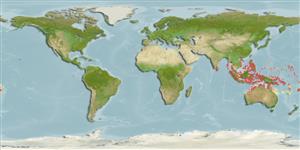Environment: milieu / climate zone / depth range / distribution range
Ökologie
seewasser riff-verbunden; standorttreu; tiefenbereich 1 - 12 m (Ref. 90102), usually 2 - 3 m (Ref. 9790). Tropical; 19°N - 23°S
Western Pacific: Philippines, Borneo, Moluccas, Papua New Guinea, New Caledonia, Palau, and Yap Island to Ishigaki Island. Range extended to Mentawai Islands (Indonesia).
Size / Gewicht / Alter
Maturity: Lm ? range ? - ? cm
Max length : 50.0 cm TL Männchen/unbestimmt; (Ref. 9710); common length : 35.0 cm TL Männchen/unbestimmt; (Ref. 9790)
Rückenflossenstacheln (insgesamt) : 9 - 10; Rückenflossenweichstrahlen (insgesamt) : 11; Afterflossenstacheln: 0; Afterflossenweichstrahlen: 11. Small juveniles all black, gradually changing to the blotched pattern of the adult (Ref. 48635). Rear edge of maxilla ends well in front of eye. Prominent pit present behind upper eye. Preopercular spines short, usually 2, subequal. Infraorbital ridge usually smooth over eye. Suborbital ridge largely smooth, bearing 2 spines below eye. Oblique scale rows slanting backward above lateral line more or less equals number of lateral-line scales. Dermal papillae (10-12 in adults) on upper eye, some simple, some branched, longest not reaching supraorbital ridge. Interopercular flap usually broader than long, with several subdivisions.
Lives on sand or rubble substrates of sheltered or semi-exposed reefs to a depth of at least 8 m (Ref. 9710). Well camouflaged on reefs (Ref. 48635). Also found in coral reefs and mangrove area in about 1-12 m (Ref 90102).
Life cycle and mating behavior
Maturities | Fortpflanzung | Spawnings | Egg(s) | Fecundities | Larven
Myers, R.F., 1991. Micronesian reef fishes. Second Ed. Coral Graphics, Barrigada, Guam. 298 p. (Ref. 1602)
IUCN Rote Liste Status (Ref. 130435)
Bedrohung für Menschen
Harmless
Nutzung durch Menschen
Fischereien: kleinfischerei
Tools
Zusatzinformationen
Download XML
Internet Quellen
Estimates based on models
Preferred temperature (Ref.
123201): 27.8 - 29.3, mean 28.8 °C (based on 1532 cells).
Phylogenetic diversity index (Ref.
82804): PD
50 = 0.5625 [Uniqueness, from 0.5 = low to 2.0 = high].
Bayesian length-weight: a=0.00575 (0.00330 - 0.01002), b=3.08 (2.92 - 3.24), in cm total length, based on LWR estimates for this species & (Sub)family-body (Ref.
93245).
Trophic level (Ref.
69278): 4.5 ±0.0 se; based on diet studies.
Widerstandsfähigkeit (Ref.
120179): mittel, Verdopplung der Population dauert 1,4 - 4,4 Jahre. (Preliminary K or Fecundity.).
Fishing Vulnerability (Ref.
59153): Moderate vulnerability (40 of 100).
Nutrients (Ref.
124155): Calcium = 46.7 [23.0, 116.0] mg/100g; Iron = 0.631 [0.277, 1.412] mg/100g; Protein = 18.1 [15.9, 20.2] %; Omega3 = 0.116 [0.049, 0.325] g/100g; Selenium = 28 [14, 78] μg/100g; VitaminA = 130 [46, 351] μg/100g; Zinc = 0.916 [0.587, 1.443] mg/100g (wet weight);
